Thai Ridgeback
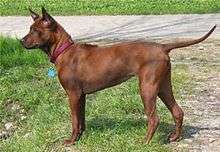 Red Thai Ridgeback | ||||||||||||||||||
| Origin | Thailand | |||||||||||||||||
|---|---|---|---|---|---|---|---|---|---|---|---|---|---|---|---|---|---|---|
| ||||||||||||||||||
| Domestic dog (Canis lupus familiaris) | ||||||||||||||||||
The Thai Ridgeback (Thai: ไทยหลังอาน, rtgs: Thai Lang-An) is an ancient landrace of dog, recently established also as a standardized breed. The breed was formerly unknown outside of Thailand, but is gaining notice in the Western world.[1] They are also known as a Mah Thai Lang Ahn. The Thai Ridgeback is one of only three breeds that has a ridge of hair that runs along its back in the opposite direction to the rest of the coat. The other two are the Rhodesian Ridgeback and the Phu Quoc Ridgeback.
Appearance
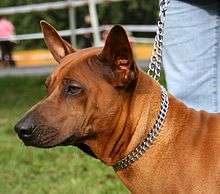
The Thai Ridgeback is a muscular, medium-sized pariah-type dog with a wedge-shaped head, triangular-shaped prick ears, and a very short, smooth coat. It has a pronounced ridge on its back formed by hair growing in the opposite direction that extends from behind the withers to the hips. Puppies are occasionally born ridgeless. Thai Ridgebacks have a muscular and streamlined body, making them extremely agile. The tail is carried upward called a sickle or sword tail. Its forehead wrinkles with enormous expression. Like many eastern breeds, the Thai Ridgeback has retained a 'scissor jaw' where upper and lower teeth interlock when the jaw bones clamp down. The tongue can be black or have black marks. Eyes are almond-shaped and brown but may be amber in blue dogs. The ears are set low and point slightly outward. The ears stand up progressively during the puppy growth period, they are not cropped. The back is straight and level. The coat is short, hard, and straight. Due to the length and density of the coat shedding is minimal, occurring once or twice yearly. Because this breed does not have an undercoat the hair does not usually bother people allergic to other breeds of dogs. Coat must be solid colors of blue, black, red or fawn with a black mask being acceptable on reds. However, brindle and white are also found but are not acceptable colors. For international show and competition, shoulder height should be 22-24 inches (56–61 cm) in males and 20-22 inches (51–56 cm) in females. The weight averages 35–55 lbs in females and 40-60 lbs in males.
Eight distinctive ridge patterns have been identified: needle, feather, arrow, lute, violin, bowling pin, leaf, and saddleback. All patterns are acceptable, but must be clearly defined and symmetrical. The broader the ridge, the more highly it is prized.[2]
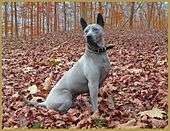 Blue Thai Ridgeback
Blue Thai Ridgeback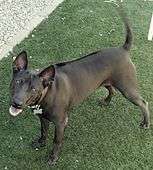 Black Thai Ridgeback
Black Thai Ridgeback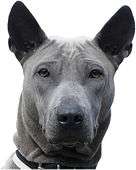 Thai Ridgeback portrait
Thai Ridgeback portrait- 6 month Thai Ridgeback
 Thai Ridgeback puppy
Thai Ridgeback puppy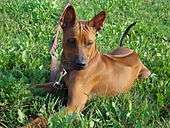 Thai Ridgeback
Thai Ridgeback
Health
Thai ridgebacks are a hearty, overall healthy breed with few inherent health issues. The breed has reproduced in Thailand almost exclusively by natural selection until the very recent past. The domesticated population is small. Inbreeding depression has not been observed in the breed. Thai Ridgeback Dogs are prone to dermoid sinus. Modern lines of Thai Ridgeback, resulting from interpopulation crosses, may also be prone to hip dysplasia and other genetic disorders.
Temperament

Thai Ridgebacks are an intelligent breed. The energy level is typically medium to high, with most of the day spent lounging and activity periods occurring in sporadic bursts. Well bred and properly socialized Thai Ridgebacks make loyal, loving family pets. They are naturally protective of their home and family and can be aggressive or shy when not properly socialized. They are best kept by consistent owners who have a thorough understanding of dog behavior. Because of prior geographic isolation and lack of human contact, the Thai Ridgeback remains independent minded and much of the original natural instinct and drives remain intact, particularly prey drive. Due to its nature, the Thai Ridgeback is not recommended for the novice dog handler. They have an excellent jumping ability and may seek to roam if not properly contained.
Genetics
Ridge
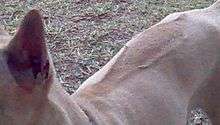
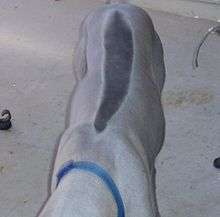
The ridgeback is under a control of two groups of epistatic genes. The first determines the existence of the ridge. The other determines the size of the ridge, from none to very large (down to the side) the latter, the more the genes in the dog, the broader is the ridge. The ridge will appear only if there is at least one dominant allele in both groups.[3]
Color
Coat color is also under a control of two groups of epistatic genes. The first determines the color of the coat if it should be black, brindle, red or white. The series of dominance is black to brindle to red to white. The intensity of the coat color is under control of a set of modifying genes. The other group controls the dilution of the colors. Black can be dilute to gray/silver/blue, and red will turn fawn. The normal color is dominance over the diluted.
History
The origin of the Thai Ridgeback is undocumented, but the breed was developed in eastern Thailand. The history of the breed is the subject of numerous hypotheses.
The other existing purebreeds of ridgeback dog are the Rhodesian Ridgeback from Africa and the Phu Quoc Ridgeback from Vietnam, which is somewhat smaller than the Thai Ridgeback. Based on genetic-based hypothesis, both Thai Ridgeback Dog and Phu Quoc Dog are likely to be descended from Funan Ridgeback Dog which originated over 1,000 years ago in Funan Era of the region. The descendent of the Hottentot Dog or Ari Dog (as called by the tribe), a known African ridge-bearing ancestor of the Rhodesian Ridgeback, is now found as Africanis. The gene that causes the ridge has been inherited from a common ancestor: "The geographical origin of the ridge present in Ridgeback dogs is still a mystery, thus solid proof has now been provided that the ridge mutation in Ridgeback dogs is identical by descent and the likelihood of parallel mutations occurring in Asia and Africa (Epstein, 1937) can therefore be rejected."[3]
See also
References
- ↑ Thai Ridgeback Dogs of the USA Breed Info
- ↑ Yvonne Kekkonen. "About the Thai Ridgeback". Archived from the original on 18 May 2010.
- 1 2 The origin of the Ridge and Associated Anomalies in Rhodesian Ridgebacks, Hillbertz 2007
External links
| Wikimedia Commons has media related to Thai Ridgeback. |